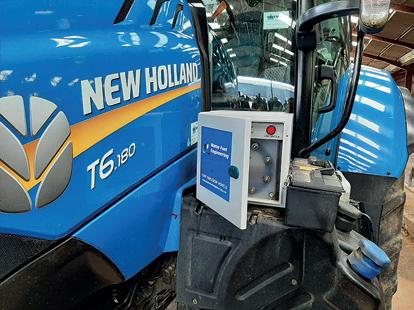
2 minute read
Trialling new tech
Rebecca Audsley, Farming for a Better Climate project lead, SAC Consulting.
In light of the renewed focus on peatland restoration, hill and fenland farmers are being urged to measure and manage their farm’s natural capital now.
Advertisement
But with mismanagement of peatland having the potential to derail the industry’s net zero ambitions, farmers must be given the right tools to do so, says Trinity AgTech’s director of business development, Anna Woodley.
“Peatland is incredibly important for improving the rural economy, domestic food security, and reaching our net zero ambitions,” explains Ms Woodley. “Yet many first-generation carbon calculators do not take peatland into account. Where it does exist, the methodology lacks sophistication and accuracy and bulks peat in the Fens is the same as the Welsh uplands, which it clearly isn’t.
“Farmers cannot be expected to be effective stewards of the land if they are not given the right insights and reliable analytics.”
Ms Woodley explains a new peatland module within next generation natural capital navigator Sandy, has recently been launched to support farmers to credibly and accurately measure their carbon and biodiversity footprints for the very first time.
Working with Focus Farmers across Scotland, we looked at practical ways to improve farm efficiency and reduce emissions. One of the innovative solutions on trial was the hydrogen electrolyser, retrofitted to farm vehicles. With the cost of fuel unlikely to fall significantly, now seems a good time to revisit.
A hydrogen electrolyser enables vehicles to run on a combination of diesel and hydrogen. Fitted to vehicles with a conventional diesel engine, the hydrogen electrolyser claims to improve fuel efficiency whilst reducing emissions.
The kit itself is about half the size of a small suitcase and consists of an electrolyser, a control unit and a water reservoir (using distilled water). The electrolyser effectively “splits” water into oxygen and hydrogen by passing an electrical current through distilled water and collecting the gases. Rather than trying to collect gases separately, the system collects “oxyhydrogen” which is injected into the conventional diesel engine.
Introducing the oxyhydrogen results in more efficient fuel combustion, a reduction in fuel use and subsequently lower emissions. Fitted to a farm telehandler during the trial period, the kit resulted in a fuel saving of 20%, which was a reduction of over 1000 litres fuel per year.
As Farming for a Better Climate moves forward, we are looking to carry out more on-farm trials and demonstrations of new and emerging technology that could, if proven, really make a difference to productivity and help further drive down farm emissions. We are currently developing our programme, but what would you like to see trialled and tested on a working farm? Get in touch at climatechange@sac.co.uk - we would love to hear from you.
To read more about the hydrogen electrolyser, or other practical ideas to improve farm efficiency and reduce the farm carbon footprint visit www. farmingforabetterclimate. org, sign up to our monthly newsletter, find us on Facebook and follow us on Twitter @SACFarm4Climate.








